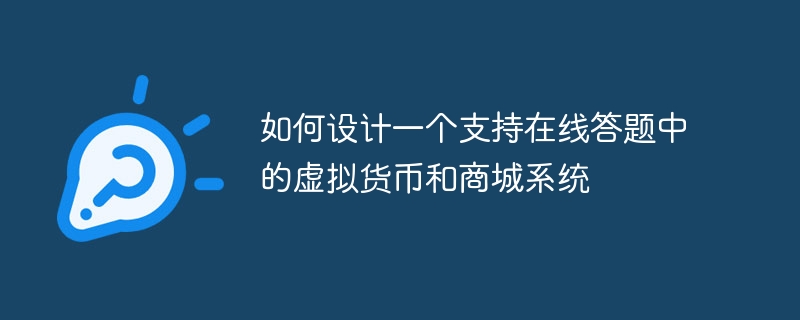Home >Backend Development >PHP Tutorial >How to design a virtual currency and mall system that supports online quizzes
How to design a virtual currency and mall system that supports online quizzes
- WBOYWBOYWBOYWBOYWBOYWBOYWBOYWBOYWBOYWBOYWBOYWBOYWBOriginal
- 2023-09-25 09:33:041564browse

How to design a virtual currency and mall system that supports online quizzes
With the development and popularization of online education, more and more people choose to use the Internet Participate in online quizzes. However, in order to increase user enthusiasm and participation, simply providing answers cannot meet their needs. Therefore, it is becoming increasingly important to design a virtual currency and mall system that supports online quizzes. By introducing virtual currency and mall systems, more rewards and incentives can be provided to users, and more profit opportunities can be created for website owners.
The following is a reference design plan for implementing a virtual currency and mall system that supports online question answering:
- User registration and login system
Users need to register and You must log in to the system to participate in online quiz activities. In order to ensure the authenticity and privacy of users, common registration and login verification methods can be used, such as mobile phone number verification, email verification, etc. - Virtual Currency System
When a user participates in a question-answering activity, a certain amount of virtual currency can be issued as a reward based on the user's answer performance. Virtual currency can be used to exchange goods or other services in the mall. - Mall system
The mall system is the core part of the entire system. It needs to provide users with the function of redeeming goods. The mall can contain various types of goods, such as physical goods, virtual goods, coupons, etc. Users can use virtual currency to exchange goods.
In the mall system, each product should have the following attributes:
- Product name
- Product description
- Product price ( Calculated in virtual currency)
- Product inventory quantity
- Product pictures
- Product exchange rules (such as whether to use additional real currency, etc.)
- Answering System
In order to maintain user activity, the answering system needs to provide some attractive content, including various question types, appropriate difficulty, and interesting questions. At the same time, certain feedback and rewards should be provided based on the user's answer performance, such as giving correct answers, increasing virtual currency rewards, etc. - Virtual Currency Circulation and Recharge
Users can obtain virtual currency in a variety of ways, such as answering questions, inviting friends, watching advertisements, etc. In addition, users can also obtain virtual currency by recharging to provide more exchange options. - User Account Management
User account management is a part of the entire system that cannot be ignored. Users can check their balance, virtual currency flow, exchange records and other information. At the same time, users can also modify personal information, set passwords, etc. - Backend management system
In order to ensure the normal operation and management of the system, the backend management system is essential. The backend management system needs to provide functions such as product management, user management, and transaction record management.
Code example:
The following is a simple code example to illustrate how to implement virtual currency circulation and recharge functions in virtual currency and mall systems.
class User:
def __init__(self, name, balance):
self.name = name
self.balance = balance
def increase_balance(self, amount):
self.balance += amount
def decrease_balance(self, amount):
self.balance -= amount
def get_balance(self):
return self.balance
class VirtualCurrency:
def __init__(self, name):
self.name = name
def transfer(self, sender, receiver, amount):
if sender.get_balance() >= amount:
sender.decrease_balance(amount)
receiver.increase_balance(amount)
def recharge(self, user, amount):
user.increase_balance(amount)
class Shop:
def __init__(self, name, price):
self.name = name
self.price = price
def buy(self, user, currency):
if user.get_balance() >= self.price:
user.decrease_balance(self.price)
return True
else:
return False
# 创建用户
user1 = User("Tom", 100)
user2 = User("Alice", 50)
# 创建虚拟货币
currency = VirtualCurrency("Coin")
# 充值
currency.recharge(user1, 50)
# 转账
currency.transfer(user1, user2, 30)
# 购买商品
shop1 = Shop("Book", 20)
shop2 = Shop("Cup", 10)
if shop1.buy(user1, currency):
print("购买成功")
else:
print("余额不足")
if shop2.buy(user2, currency):
print("购买成功")
else:
print("余额不足")This is just a simple example. The actual system requires more functions and details to meet the needs of users and the operational needs of the mall. I hope the above design plans and code examples can be helpful to you, and I wish you a smooth implementation of your online question answering project!
The above is the detailed content of How to design a virtual currency and mall system that supports online quizzes. For more information, please follow other related articles on the PHP Chinese website!

